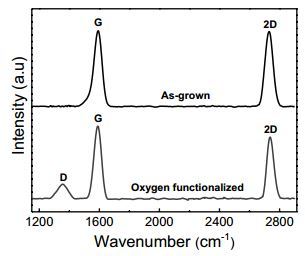 Improved Chemical Detection and Ultra-Fast Recovery Using Oxygen Functionalized Epitaxial Graphene Sensors
Improved Chemical Detection and Ultra-Fast Recovery Using Oxygen Functionalized Epitaxial Graphene Sensors
Oxygen functionalized epitaxial graphene (OFEG) sensors are demonstrated toward the sensing of polar chemical vapors at room temperature. The electrical characteristics of the sensor show an increase in resistance upon exposure to polar protic chemicals while the resistance decreased for polar aprotic vapors The average response and recovery times of the OFEG sensor to all analyte vapors are 10 and 100 s, respectively. In comparison, non-functionalized epitaxial graphene (NFEG) sensors show similar response times as OFEG, but with extremely long recovery rates in the range of similar to 1.5–2 hours. The dipole moment of the chemical is found to have a strong impact on the magnitude of the response for both OFEG and NFEG which increased with the increasing dipole moment from 2.0 D to 4.1 D. However, OFEG exhibits significantly higher sensitivity (twofold increase) to all polar chemicals over NFEG sensors. For example, exposing OFEG to n-methyl-2-pyrrolidone vapors produces a 45% change in resistance, in comparison to a 27% resistance change displayed by NFEG sensors. The noise spectral density of NFEG follows a typical 1/f dependence upon exposure to di-methylformamide vapors but with a lower change in noise from 1×10−18 A2/Hz to 1×10−17 A2/Hz at 1 Hz. In contrast, OFEG displays a unique 1/f 2 behavior at lower frequency range (1–10 Hz) with a significant change to the sensor noise from 3×10−18A2/Hz to 2×10−15 A2/Hz.
Go back